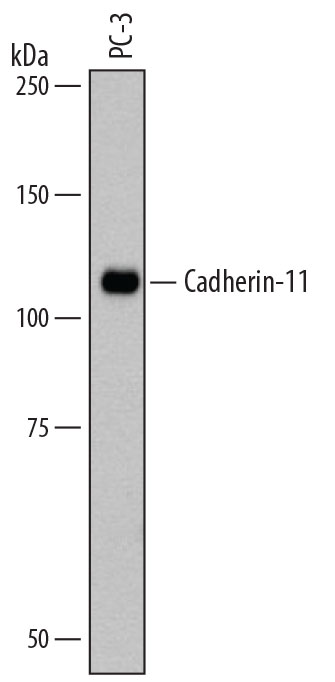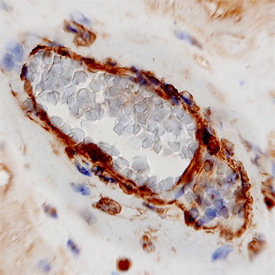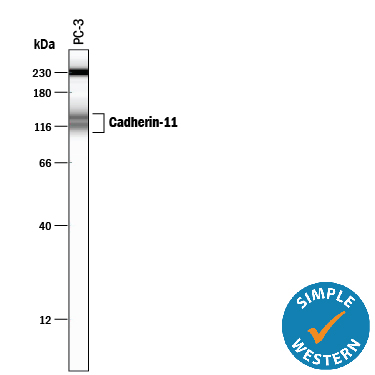Human Cadherin-11 Antibody Summary
Applications
Please Note: Optimal dilutions should be determined by each laboratory for each application. General Protocols are available in the Technical Information section on our website.
Scientific Data
 View Larger
View Larger
Detection of Human Cadherin‑11 by Western Blot. Western blot shows lysates of PC-3 human prostate cancer cell line. PVDF membrane was probed with 1 µg/mL of Mouse Anti-Human Cadherin-11 Monoclonal Antibody (Catalog # MAB1790) followed by HRP-conjugated Anti-Mouse IgG Secondary Antibody (Catalog # HAF007). A specific band was detected for Cadherin-11 at approximately 110 kDa (as indicated). This experiment was conducted under reducing conditions and using Immunoblot Buffer Group 1.
 View Larger
View Larger
Cadherin‑11 in Human Placenta. Cadherin-11 was detected in immersion fixed paraffin-embedded sections of human placenta using Mouse Anti-Human Cadherin-11 Monoclonal Antibody (Catalog # MAB1790) at 8 µg/mL overnight at 4 °C. Tissue was stained using the Anti-Mouse HRP-DAB Cell & Tissue Staining Kit (brown; Catalog # CTS002) and counterstained with hematoxylin (blue). View our protocol for Chromogenic IHC Staining of Paraffin-embedded Tissue Sections.
 View Larger
View Larger
Detection of Human Cadherin‑11 by Simple WesternTM. Simple Western lane view shows lysates of PC‑3 human prostate cancer cell line, loaded at 0.2 mg/mL. Specific bands were detected for Cadherin‑11 at approximately 114 & 137 kDa (as indicated) using 20 µg/mL of Mouse Anti-Human Cadherin‑11 Monoclonal Antibody (Catalog # MAB1790). This experiment was conducted under reducing conditions and using the 12-230 kDa separation system. Non-specific interaction with the 230 kDa Simple Western standard may be seen with this antibody.
Reconstitution Calculator
Preparation and Storage
- 12 months from date of receipt, -20 to -70 degreesC as supplied. 1 month, 2 to 8 degreesC under sterile conditions after reconstitution. 6 months, -20 to -70 degreesC under sterile conditions after reconstitution.
Background: Cadherin-11
The cadherin superfamily comprises a large number of membrane glycoproteins with one or more cadherin repeats, which are involved in Ca 2+ dependent cell-cell adhesion. The family can be subdivided into several major subgroups, including the type I and type II classical cadherins, desmosomal cadherins, protocadherins, seven transmembrane (Flamingo) cadherins, FAT-family cadherins, T-cadherin and other unclassified cadherins (1). Cadherin-11, also known as OB-cadherin, is a type II classical cadherin. Classical cadherins are type I transmembrane proteins with an N-terminal extracellular domain containing five tandem cadherin repeats and a C-terminal cytoplasmic domain with a characteristic sequence for binding to catenins. Type I cadherins (E-, N-, P-, R-, M-, and EP-cadherin) differ from type II cadherins (cadherin-5 to -12, -18 to -20 and -22) by the presence of the HAV tripeptide motif in the most N-terminal cadherin repeat (2). Classic cadherins mediate cell-cell adhesion preferentially via homotypic interactions and form adherens juctions that have beta -catenin and p120 (ctn) at the cytoplasmic side of the junction (3, 4). Homotypic cadherin interactions also transduce outside-in and inside-out cell signals. Cadherin signaling induces various cellular processes including cell motility, actin cytoskeleton reorganization, proliferation, and differentiation (3, 4). Cadherin-11 is expressed in a variety or normal tissues of mesodermal origin including areas of the kidney and brain, in normal osteoblasts, and in tumors of the stomach, kidney, colon, breast, and bone (osteosarcoma) (5, 6). It is also differentially expressed in the embryonic brain and may be important in regulating neural development. Human Cadherin-11 exhibits a unique mRNA splice site allowing for two forms of the protein to be expressed, a full-length 796 amino acid (aa) protein and a COOH terminus-truncated variant of 693 aa. The truncated variant has a unique cytoplasmic region due to a frameshift event (3). The full-length human and mouse Cadherin-11 share 97% homology at the aa sequence level.
- Angst, B.D. et al. (2001) J. Cell Sci. 113:629.
- Gessner, R. and R. Tauber (2000) Ann. N.Y. Acad. Sci. 915:136.
- Feltes, C.M. et al. (2002) Cancer Research. 62:6688.
- Wheelock, J.J. and K.R. Johnson (2003) Annu. Rev. Cell Dev. Biol. 19:207.
- Hoffmann, I. and R. Balling (1995) Dev. Biol. 169:337.
- Pishvaian, M.J. et. al. (1999) Cancer Research 59:947.
Product Datasheets
Citations for Human Cadherin-11 Antibody
R&D Systems personnel manually curate a database that contains references using R&D Systems products. The data collected includes not only links to publications in PubMed, but also provides information about sample types, species, and experimental conditions.
7
Citations: Showing 1 - 7
Filter your results:
Filter by:
-
Production and Secretion of Gelsolin by Both Human Macrophage- and Fibroblast-like Synoviocytes and GSN Modulation in the Synovial Fluid of Patients with Various Forms of Arthritis
Authors: J Feldt, M Schicht, J Welss, K Gelse, S Sesselmann, M Tsokos, E Socher, F Garreis, T Müller, F Paulsen
Biomedicines, 2022-03-21;10(3):.
Species: Human
Sample Types: Whole Cells
Applications: ICC -
A subset of activated fibroblasts is associated with distant relapse in early luminal breast cancer
Authors: C Bonneau, A Eliès, Y Kieffer, B Bourachot, S Ladoire, F Pelon, D Hequet, JM Guinebreti, C Blanchet, A Vincent-Sa, R Rouzier, F Mechta-Gri
Breast Cancer Res., 2020-07-14;22(1):76.
Species: Human
Sample Types: Cell Lysate
Applications: Western Blot -
The role of cadherin-11 in microcystin-LR-induced migration and invasion in colorectal carcinoma cells.
Authors: Zhu Q, Wang Z, Zhou L, Ren Y, Gong Y, Qin W, Bai L, Hu J, Wang T
Oncol Lett, 2017-11-21;15(2):1417-1422.
Species: Human
Sample Types: Whole Cells
Applications: ICC -
Cadherin-11 expression is upregulated in invasive human breast cancer
Authors: K Pohlodek, YY Tan, CF Singer, D Gschwantle
Oncol Lett, 2016-10-10;12(6):4393-4398.
Species: Human
Sample Types: Whole Tissue
Applications: IHC-P -
Cadherin-11 in renal cell carcinoma bone metastasis.
Authors: Satcher R, Pan T, Cheng C, Lee Y, Lin S, Yu G, Li X, Hoang A, Tamboli P, Jonasch E, Gallick G, Lin S
PLoS ONE, 2014-02-24;9(2):e89880.
Species: Human
Sample Types: Whole Cells
Applications: Neutralization -
N-cadherin-mediated cell-cell adhesion promotes cell migration in a three-dimensional matrix.
Authors: Shih W, Yamada S
J Cell Sci, 2012-03-30;125(0):3661-70.
Species: Canine
Sample Types: Cell Lysates
Applications: Western Blot -
Hypoxia-induced abrogation of contact-dependent inhibition of rheumatoid arthritis synovial fibroblast proliferation.
Authors: Nonomura Y, Mizoguchi F, Suzuki A
J. Rheumatol., 2009-02-17;36(4):698-705.
Species: Human
Sample Types: Cell Lysates
Applications: Western Blot
FAQs
No product specific FAQs exist for this product, however you may
View all Antibody FAQsReviews for Human Cadherin-11 Antibody
There are currently no reviews for this product. Be the first to review Human Cadherin-11 Antibody and earn rewards!
Have you used Human Cadherin-11 Antibody?
Submit a review and receive an Amazon gift card.
$25/€18/£15/$25CAN/¥75 Yuan/¥2500 Yen for a review with an image
$10/€7/£6/$10 CAD/¥70 Yuan/¥1110 Yen for a review without an image

